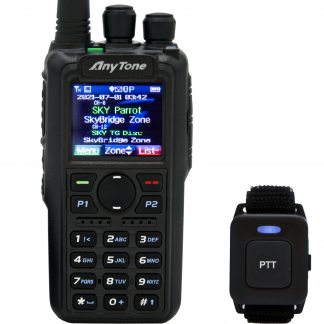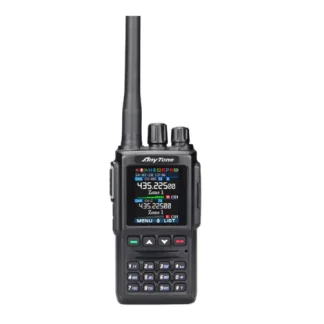In today’s rapidly evolving world, communication is key, especially in emergencies. Whether it’s a natural disaster, a power outage, or even a complete breakdown of communication networks, ham radio operators play a crucial role in keeping the lines of communication open. The new Anytone D168UV dual-band radio is here to enhance that role, providing ham radio enthusiasts and emergency responders with an all-in-one solution that’s built to perform in the most critical situations. Why Ham Radio Operators Are Essential in Emergencies
Why Ham Radio Operators Are Essential in Emergencies
During disasters or emergency situations, mainstream communication networks—cellular towers, landlines, and the internet—are often compromised. This is where ham radio operators come into play. Licensed operators with their ham radios provide a decentralized, reliable communication method that isn’t dependent on traditional infrastructure. They act as a lifeline for emergency services and communities, relaying important information when other systems fail.
However, not all ham radios are created equal. You need a device that is versatile, powerful, and easy to use in the heat of the moment. Enter the Anytone D168UV, a dual-band ham radio that is perfect for emergency communication needs.
Features of the Anytone D168UV That Shine in Emergencies
1. Dual-Band Capability
The Anytone D168UV operates on both VHF and UHF frequencies, making it an incredibly versatile tool in emergency situations. VHF (Very High Frequency) is great for long-range communication, especially in open spaces, while UHF (Ultra High Frequency) excels in urban settings where buildings and other obstacles may interfere with signals. Having access to both bands ensures that operators can adapt to any environment or scenario.
2. High Power Output
With up to 5 watts of power, the Anytone D168UV provides robust signal strength, allowing you to reach longer distances compared to lower-powered models. This makes it perfect for coordinating rescue efforts, keeping in touch with remote locations, or communicating with emergency responders who may be operating miles away. In disaster zones where reaching the nearest relay station or other operators could be a challenge, this radio’s high power output becomes a game-changer.
3. Compact and Durable Design
In an emergency, you need equipment that can survive tough conditions. The Anytone D168UV is compact and lightweight, but don’t let its size fool you—it’s built to withstand rugged environments. Its durable housing ensures that it can endure drops, bumps, and the inevitable wear and tear that comes with emergency response work.
4. Long Battery Life
One of the worst situations you can find yourself in during an emergency is a dead radio. The Anytone D168UV is equipped with a long-lasting battery, giving you extended communication time when it matters most. Many users also appreciate the fact that you can charge the radio via USB, allowing for easier charging on the go, whether you’re using a solar charger, car adapter, or portable power bank.
5. Easy-to-Use Interface
When things go wrong, you don’t have time to fumble with complicated devices. The Anytone D168UV is designed with simplicity in mind, featuring an intuitive interface that even new ham radio operators can quickly learn to use. The clear LCD display, straightforward button layout, and user-friendly programming make it easy to get up and running fast in an emergency.
6. Wide Frequency Range
The Anytone D168UV can operate on a broad range of frequencies, making it ideal for both amateur and emergency communications. Many ham radio operators are part of local emergency response teams or organizations like ARES (Amateur Radio Emergency Service). With this radio, you can easily switch between personal communication and emergency channels, ensuring you stay connected to both your community and official responders.
How the Anytone D168UV Excels in Real Emergencies
Ham radio operators have been instrumental in providing disaster relief communication for decades. With the advancement in radio technology, such as the Anytone D168UV, their role has become even more impactful. Here’s how:
- Disaster Preparedness: In many natural disasters, such as hurricanes, earthquakes, and wildfires, traditional communication methods can be knocked out. Ham radios like the Anytone D168UV remain operational, allowing for coordination between rescue teams, medical personnel, and community leaders. The dual-band functionality ensures communication can happen across multiple channels and distances.
- Coordination in Remote Areas: In rural or mountainous areas where cell phone service is often weak or nonexistent, the Anytone D168UV becomes a critical tool. Its high power output and frequency range enable operators to establish communication links in areas that might otherwise be unreachable.
- Backup for First Responders: In times of crisis, first responders may become overwhelmed. Ham radio operators equipped with reliable radios like the Anytone D168UV can serve as vital backups, relaying emergency information when official channels are overloaded.
- Community Communication: In situations where people are cut off from family or services, ham operators using the Anytone D168UV can assist with welfare checks, ensuring that everyone in the community is accounted for and safe.
Conclusion: Be Prepared with the Anytone D168UV
In emergencies, you need more than just a good radio—you need the best. The Anytone D168UV offers the features and reliability that make it an indispensable tool for ham radio operators, emergency responders, and community leaders alike. With dual-band capability, high power output, a durable design, and an easy-to-use interface, it’s a must-have for anyone serious about disaster preparedness and communication.
By equipping yourself with the Anytone D168UV, you’re not just investing in a radio—you’re investing in peace of mind, knowing that when disaster strikes, you’ll be ready to take action.



